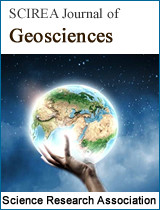Spatial Correlation Analysis of Urban Air Quality in Henan Province
DOI: 278 Downloads 14863 Views
Author(s)
Abstract
Aiming at the impact relationship between urban air qualities, this paper uses correlation analysis methods to study the spatial correlation distribution characteristics of urban air quality and its relationship with topography, and uses the partial correlation and multiple correlation analysis to explore the impact degree between cities in the strong correlation region, as well as the city atmosphere type. The results show that: (1) There is a significant correlation between urban air quality in Henan province, the correlation is linear with distance, and propagation ability is inverse proportional with terrain elevation; (2)The province's air quality presents three independent systems and four relevance belt, the cities in the northern area have north-south correlation characteristics, and the cities in the central area have northwest-southeast correlation characteristics; (3)The cities whose air quality is greatly affected by neighboring cities in the topography are distributed along the 250m elevation belt, Luohe, Zhengzhou and Anyang are air pollution radiation cities, which greatly affect the air quality of Xuchang, Zhumadian, Xinxiang and Hebi.
Keywords
Urban air qualities; Correlation analysis; Partial correlation analysis; Multiple correlation analysis; Spatial relationship; Henan province
Cite this paper
ZHANG Kaiguang, BA Mingtong, MENG Hongling, SUN Yanmin,
Spatial Correlation Analysis of Urban Air Quality in Henan Province
, SCIREA Journal of Geosciences.
Volume 3, Issue 1, February 2019 | PP. 1-12.
References
| [ 1 ] | LIN Xueqin, WANG Dai. (2016). Spatiotemporal evolution of urban air quality and socioeconomic driving forces in China. Journal of Geographical Sciences, 26(11), 1533-1549. |
| [ 2 ] | Ma Z, Hu X, Sayer A, et al. (2016). Satellite-based spatiotemporal trends in PM2.5concentrations:China, 2004-2013. Environmental Health Perspectives, 124, 184-192. |
| [ 3 ] | Liu H M, Fang C L, Zhang X L, et al.(2017). The effect of natural and anthropogenic factors on haze pollution in Chinese cities: A spatial econometrics approach. Journal of Cleaner Production, 165,323-333. |
| [ 4 ] | Jiang Lei, Zhou Haifeng, Bai Ling, et al. (2018). The analysis of socio-economic factors of air quality index (AQI) based on the perspective of the exponential decay effects. Acta Scientiae Circumstantiae, 38(1), 390-398. |
| [ 5 ] | BIE Tong, HAN Lijian, HE Liang, et al. (2018). Impact of urban air pollution on surrounding areas in Beijing, Tianjin, and Hebei Provinces. Acta Ecologica Sinica, 38 (12), 4268-4275. |
| [ 6 ] | MI Kena, ZHUANG Rulong , LIANG Longwu, et al. (2018). Spatio-temporal evolution and characteristics of PM2.5 in the Yangtze River Delta based on real-time monitoring data during 2013-2016. Geographical Research, 37(08), 1641-1654. |
| [ 7 ] | LU Lingyue, Li Hongyuan. (2016). Air Quality Evaluation of Beijing-Tianjin-Hebei Region of China Based on the Fuzzy Comprehensive Evaluation Method. Acta Scientiarum Naturalium Universitatis Nankaiensis, 49 (1), 62-68 . |
| [ 8 ] | BIE Tong, HAN Lijian, TIAN Shufang, et al. (2018). Method for quantifying the contribution of urbanization on population exposure to air pollution. Acta Ecologica Sinica, 38 (13), 4570-4583. |
| [ 9 ] | Wang Zhenbo, Liang Longwu, Lin Xiongbin, et al. (2017).Control models and effect evaluation of air pollution in Jing-Jin-Ji urban agglomeration. Environmental Science, 2017, (10), 1-12. |
| [ 10 ] | LI Wenjie, ZHANG Shihuang, GAO Qingxian, et al. (2012). Relationship between Temporal-Spatial Distribution Pattern of Air Pollution Index and Meteorological Elements in Beijing, Tianjin and Shijiazhuang. Resources Science, 34 (8), 1392-1400. |
| [ 11 ] | CHEN Liding, ZHOU Weiqi, HAN Lijian, et al. (2016). Developing key technologies for establishing ecological security patterns at the Beijing-Tianjin-Hebei urban megaregion. Acta Ecologica Sinica, 36 (22), 7125-7129. |
| [ 12 ] | WANG Jingyun, ZHANG Hongri, ZHAO Xiangwei, et al. (2012). Variation of Air Quality Index and Its Relationship With Meteorological Elements in Beijing from 2012 to 2015. Meteorological and Environmental Sciences, 40(04), 35-41. |
| [ 13 ] | LIAO Zhiheng, SUN Jiaren, FAN Shao-jia, et al. (2012). Variation characteristics and influencing factors of air pollution in Pearl River Delta area from 2006 to 2012. China Environmental Science, 35(02), 329-336. |
| [ 14 ] | XU Zheng, PU Qing, ZOU Bin. (2017). A geographical information service system of urban air quality under Web mode. Science of Surveying and Mapping, 42(2), 47-52. |
| [ 15 ] | Li L, Qian J, Ou C Q, et al. (2014). Spatial and temporal analysis of Air Pollution Index and its timescale-dependent relationship with meteorological factors in Guangzhou, China, 2001-2011. Environmental Pollution, 190, 75-81. |
| [ 16 ] | WANG Guanlan,XUE Jianjun,ZHANG Jianzhong.(2016). Analysis of Spatial-temporal Distribution Characteristics and Main Cause of Air Pollution in Beijing-Tianjin-Hebei Region in 2014. Meteorological and Environmental Sciences,39( 1), 34 -42. |
| [ 17 ] | DENG Xiajun, CAI Zhenqun, XIANG Xiaomei, et al. (2015). Air Pollutant Timing Characteristics and Its Correlation with Meteorological Conditions in Lishui. Meteorological and Environmental Sciences, 38 (2), 60-65. |
| [ 18 ] | HAO Kaiyue, CHEN Xiangyu, LI Yuanwei, et al. (2018). Correlative Analysis of Ultraviolet Radiation and Air Quality in Linzhi. Environmental Science & Technology, 41(7), 103-106. |
| [ 19 ] | ZHU Changlin, MENG Shuangshuang, ZHANG Rongguo. (2017). Correlation analysis and spatial and temporal distribution characteris of main atmospheric pollutants in xi'an. Environmental Engineering, 35(12),86-91. |
| [ 20 ] | YU Dajiang, WU Yanling, LI Hongji,et al. (2014). Long-term variations of the air quality in 6 cities in northeast China. Environmental Chemistry, 33(06), 956-961. |
| [ 21 ] | ZHANG Kaiguang, BA MIngting,MENG Hongling. (2018). Correlation analysis of elevation and relief degree of land surface in Henan province. Advances in Intelligent system Research, 143, 271-275. |
| [ 22 ] | FENG Zhiming,TANG Yan, YANG Yanzhao,et al. (2016).The Relief Degree of Land Surface in China and Its Correlation with Population Distribution. Acta Geographica Sinica, 62(10), 10 |

